Niagara-on-the-Lake, Ontario 作者: 来源: 发布时间:2021-12-07
I.Population and Area
-Area
Land: 132.81 km2 (51.28 sq mi)
-Population (2016)
Total: 17,511
Density: 131.8/km2 (341/sq mi)
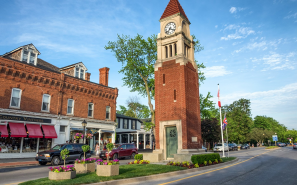
II.Natural Geography (environment and resources)
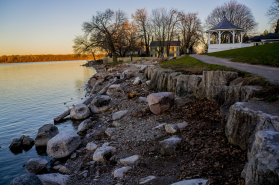
-Niagara-on-the-Lake is a town in Ontario, Canada. It is located on the Niagara Peninsula at the point where the Niagara River meets Lake Ontario, across the river from New York, United States. Niagara-on-the-Lake is in the Niagara Region of Ontario, and is the only town in Canada that has a Lord Mayor. It has a population of 17,511 (2016).
-Niagara-on-the-Lake is important in the history of Canada: it served as the first capital of the Province of Upper Canada, the predecessor of Ontario, called Newark from 1792 to 1797. During the War of 1812, the town, the two former villages of St. David's and Queenston, and Fort George were the site of numerous battles following the American invasion of Upper Canada, and the town was razed. Niagara-on-the-Lake is home to the oldest Anglican and Catholic churches in Ontario, and the oldest surviving golf course in North America.
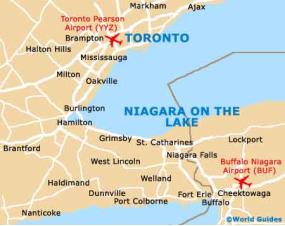
-Today, Niagara-on-the-Lake draws tourists with its quaint colonial-style buildings, the Shaw Festival, Fort George, wineries, an outlet mall on the highway, and its proximity to Niagara Falls. The Niagara Region has the second-highest percentage of seniors in Ontario. Niagara-on-the-Lake has been rated among the best places to retire in Ontario according to Comfort Life, a publication for seniors.
-Niagara-on-the-Lake can be reached by Queen Elizabeth Way, a highway that stretches to Fort Erie to the south, Hamilton to the west and curves around Lake Ontario to Toronto. Public transportation is served by Niagara-on-the-Lake Transit.
III.ECONOMY
-The average salary in Niagara-on-the-Lake, Ontario is C$55k. Trends in wages decreased by -100.0 percent in Q1 2020. The cost of living in Niagara-on-the-Lake, Ontario is 100 percent higher than the national average. The most popular occupations in Niagara-on-the-Lake, Ontario are Retail Store Manager, Operations Manager, and Software Engineer which pay between C$34k and C$99k per year. The most popular employers in Niagara-on-the-Lake, Ontario are Andrew Peller Limited, Vintage Hotels, and Brewers Distributing.

-Website: https://www.payscale.com/research/CA/Location=Niagara-on-the-Lake-Ontario/Salary
IV.Industrial Characteristics
-The town is home to the Shaw Festival, Canada's second largest producing theatre and a repertory company featuring the works of George Bernard Shaw, his contemporaries, or plays about his era (1856–1950), running from April to December. The festival operates Four theatres in the centre of town: the Festival, The Jackie Maxwell Studio, The Royal George, and the Court House theatre. The Festival produces over 750 performances annually featuring its lauded repertory ensemble and employs over 520 artist, artisans and artsworkers locally
-Along the Niagara Parkway is RiverBrink Art Museum in Queenston. It is home to a collection of over 1,400 artworks and artefacts by Canadian and international artists, assembled by Samuel E. Weir. Completed in 1970, the building features Georgian-style architecture, including a mansard roof and gabled windows. It served as Weir's country residence, and was converted into an art museum following his death in 1981.
V.Attractions
1.Rainbow International Bridge
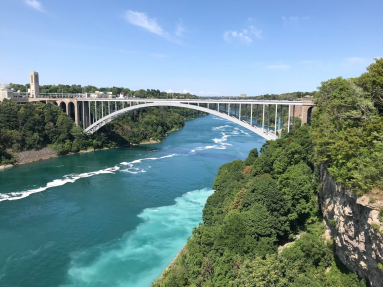
-The Niagara Falls International Rainbow Bridge, commonly known as the Rainbow Bridge, is an arch bridge across the Niagara River gorge. It connects the cities of Niagara Falls, New York, United States (to the east), and Niagara Falls, Ontario, Canada (west).
-The Rainbow Bridge was built near the site of the earlier Honeymoon Bridge, which collapsed on January 27, 1938, due to an ice jam in the river. A joint Canadian and American commission had been considering a new bridge to replace it, and the collapse added urgency to the project.
-A design by architect Richard (Su Min) Lee was chosen (and used again for the Lewiston-Queenston Bridge, approximately 10 kilometres (6 mi) downriver). The bridge's Rainbow Tower and Canadian plaza are the work of Canadian architect William Lyon Somerville. King George VI and Queen Elizabeth, during their visit to Niagara Falls as part of the 1939 royal tour of Canada, dedicated the site of the Rainbow Bridge; a monument was erected to commemorate the occasion. Construction began in May 1940. The bridge officially opened on November 1, 1941.
-The origin of the bridge's name is unknown, with one possible source being T. B. McQuesten, then chairman of the Niagara Parks Commission. An engraving on the Canadian side of the bridge includes a biblical quote from the Book of Genesis which references a "bow in the clouds." Regardless of its origin, the NRBC used the name as early as March 1939.
-The New York State Department of Transportation designates the bridge as NY 955A, an unsigned reference route, while the Ontario Ministry of Transportation designates it as part of Highway 420 (and the original routing of the Queen Elizabeth Way), even though it is separated from the rest of the route by a regional road. On the American side, a number of state and national routes end at a set of intersections in front of the bridge. New York routes 104 and 384, as well as the northern section of the Robert Moses State Parkway, all terminate at the final intersection before the bridge, and none of the designations passes onto the bridge. U.S. Route 62 terminates two blocks north at route 104, which then continues to the bridge. The Rainbow Tower, part of the plaza complex on the Canadian side, houses a large carillon, which plays several times daily.
-The bridge permits no commercial trucks; the nearest border crossing for these is the Lewiston-Queenston Bridge.
-The toll to cross the bridge for each pedestrian and bicycle is $1.00 US or CAD, and $3.75 US or $5.00 CAD for automobiles as of February 2018. Car tolls are collected when leaving the United States. Pedestrian toll is collected by an automatic turnstile when leaving Canada, payable in U.S. or CAD quarters or $1 CAD 'loonies'. Change machines are available from $1 and $5 US bills and $1 (loonies) and $2 (toonies) Canadian coins.
-Address: 5702 Falls Ave, Niagara Falls, ON L2G 3K7
-Phone:
-Website: https://www.niagarafallslive.com/rainbow_bridge.htm
2. Niagara Parks Butterfly Conservatory
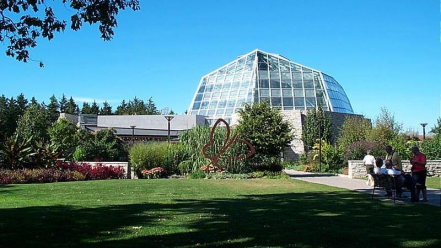
-The Niagara Parks Butterfly Conservatory is a butterfly house operated by the Niagara Parks Commission in Niagara Falls, Ontario, Canada. It is located approximately 9 kilometres (5.6 mi) north of Niagara Falls on the grounds of the Niagara Parks School of Horticulture, which is 40 hectares (99 acres) in size.
-The conservatory was opened in December 1996 with a gift shop, 200-seat theater/auditorium room, and a climate-controlled greenhouse. The conservatory has over 2,000 tropical butterflies from over 60 different species. The conservatory glass dome is 1,022 square metres (11,000 sq ft) in size with 180 metres (590 ft) of paths inside the greenhouse portion, which has a wide variety of foliage. The conservatory can accommodate up to 300 visitors per hour. Since captive butterflies usually have a life span of 2–4 weeks, the conservatory imports up to 3,000 butterflies per month from world butterfly farms in Costa Rica, El Salvador, the Philippines, and Australia. Special netting along the inside of the glass dome keeps the butterflies from getting stuck to it and from dying from hypothermia. Butterfly food plants at the conservatory such as Lantana, Cuphea, Zinnia, Ixora, Liatris, and Pentas are replaced every 2–3 weeks because caterpillars have large appetites.
-Visitors who want the butterflies to land on them should wear bright clothes, move slowly, and wear perfume or cologne. Eurasian quails, turtles, goldfish, toads, and beetles help keep the insect population in balance. The Emergence area allows visitors to view the butterfly life cycle and produces over 45,000 butterflies annually.
-The species of butterfly at the conservatory include the banded orange, blue morpho, common Mormon, cydno longwing, Doris longwing, Gulf fritillary, Julia, Low's swallowtail, monarch, mosaic, owl, red lacewing, Sara longwing, and small postman.
-Address: 2565 Niagara Pkwy, Niagara-on-the-Lake, ON L0S 1J0
-Website: https://www.niagaraparks.com/visit/attractions/butterfly-conservatory/
3.Floral Clock
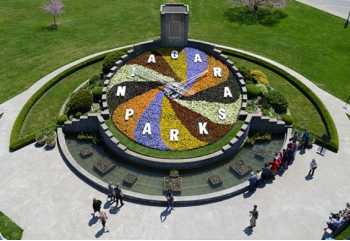
-The Niagara Parkway, running along its namesake river, is both a scenic road in its own right and host a wealth of discovery with the features and stopovers along its route. Arguably the most iconic of these stopovers, only a short drive north from the Botanical Gardens, is the famous Floral Clock.
-SINCE 1950
-Located near the Niagara Botanical Gardens, the fully-functional Floral Clock, with a diameter of 12.2 metres, was fashioned in 1950, based off the famous Princes Street Gardens in Edinburgh. The clock and its associated grounds has operated as a free attraction ever since – and has become one of the most photographed attractions in the region.
-The clock is constantly kept in peak condition. The mechanism is regularly maintained by Ontario Water, the original designers of the clock, along with a Westminster chime every hour and quarter-hour. The garden bedding on the clock’s surface is regularly groomed and updated by staff from Niagara Parks.
-OVER 15000 PLANTS
-Anywhere between 16 000 to 20 000 carpet bedding plants make up the surface of the clock, with the floral theme changing throughout the year. Spring might use viola, along with green and grey Santolina sage in Fall. Depending on the time of year the curators might also introduce perennials or rock-garden aesthetics to ensure there’s always a variety in the clock itself and the surrounding gardens.
-DESIGN CHANGES EACH YEAR
-The design changes each year, and visitors with a mind for history will be intrigued by the multitude of photos housed in the clock’s tower, chronicling the changing face of the clock in the past half-century.
-Ideal viewing times are between April and September, and the grounds are open to visitors all year round. A local gift shop is mostly open from May until October.
-The Floral Clock of Niagara is one of the largest of its kind in the world, and is an ideal stopping point in the scenic drive between Niagara Falls and Niagara-on-the-Lake. For anyone driving by, stopping is a must, to see the latest design and capture a premier photo opportunity.
-While in Niagara Falls stay at the highly rated four star Marriott on the Falls Hotel. Combine our best rates with valuable add-ons with one of our:
-Address:
14004 Niagara Pkwy,
Niagara Falls, Canada
Phone: (905) 357-2411
-Website: https://www.marriottonthefalls.com/attractions/floral-clock/
VI.History
-Before the British settlers came, the point where Fort Mississauga is situated was used by at least three Native American tribes: the Neutral (15th century); Seneca (late 17th century); and Mississauga (18th century).
-The settlement was founded in 1781 as Butlersburg, in honour of Colonel John Butler, the commander of Butler's Rangers. It was later renamed West Niagara to distinguish it from Fort Niagara. It was a British military base and haven for pro-British loyalists fleeing the United States during the volatile aftermath of the American Revolution.
-Renamed Newark by Lieutenant-Governor John Graves Simcoe in 1792, it was the first capital of Upper Canada (now the province of Ontario). The Upper Canada legislature first met at Navy Hall on September 17, 1792 and met here another four times until June 1796. In 1797, Simcoe moved the capital to York because Newark was very close to the border with the U.S. Newark was renamed Niagara in 1798.
-Fort George, just south of the settlement, was built in 1796-1799. During the War of 1812, Niagara was taken in the Battle of Fort George by American forces in May 1813 after a two-day bombardment by cannon from Fort Niagara and the American fleet, followed by a fierce battle. After capturing Fort George, the Americans built their own fortifications here. The fort was retaken by the British in December 1813 but left to fall into ruins and abandoned in 1815. Only a small portion of the fort remains; it has been fully restored. Fort Mississauga was built, starting in 1813, but was not completed until after the war in 1816.
-During the war, the settlement of Niagara was razed and burnt to the ground by American soldiers as they withdrew to Fort Niagara. (Afterwards, on December 19, 1813, the British captured Fort Niagara.) The citizens rebuilt Niagara after the war, with the residential quarter around Queen Street and toward King Street, where the new Court House was rebuilt out of range of Fort Niagara's cannons.
-The Smith's Canadian Gazetteer of 1846 describes "Niagara (formerly called Newark)" as follows:
"It has been a place of considerable trade. On the east side of the town is a large military reserve. About half a mile up the river are the ruins of Fort George, where the remains of General Brock were originally interred; they were removed. A new town-hall and court-house are intended to be erected by the town. There is a fire brigade with two engines and a hook and ladder company. Churches and chapels total five. Two newspapers are published weekly .... Steamboats run daily, as long as the weather will allow of it, from Toronto .... The Niagara Harbour and Dock Company were incorporated in the year 1830 .... the vessels turned out by the Company the steamboat "London," which commenced running in the spring of 1845, the fastest boat on the upper lakes... The Company usually employ about 150 hands; and, when particularly busy, have employed as many as 350. There is also on the premises a marine railway, large enough for hauling up vessels of the first class. Post Office, post every day. Professions and Trades.—Three physicians and surgeons, nine lawyers, twelve stores, taverns, two chemists and druggists, three booksellers and stationers, two saddlers, four wagon makers, two watchmakers, two tallow-chandlers, marble works, two printers, two cabinet makers, one hatter, four bakers, two livery stables, two tinsmiths, three blacksmiths, six tailors, seven shoemakers, one tobacconist, one bank agency, .... large quantities of apples, peaches, and cider are shipped annually."
-In 1859 the town built its first public school, Niagara Public School.
-The town's present name of Niagara-on-the-Lake was adopted around 1880 as a Postal Address to distinguish the town from Niagara Falls. The name was not officially adopted until 1970, when the Town of Niagara and the Township of Niagara merged.
VII.Other information
-Member of Parliament for Niagara Falls, Minister of Justice and Attorney General of Canada. “"A new, modern wastewater facility will help safeguard the environment for future generations by ensuring that water returned to Lake Ontario meets or even exceeds treatment standards."”
-“"The Ontario government understands how important this wastewater treatment plant is to the Niagara Region, and we are proud to support the needs of local families and businesses by contributing to this significant project,"” said Kim Craitor, Member of Provincial Parliament for Niagara Falls. “"By making strategic investments in infrastructure, our government is continuing to strengthen our economy and building stronger communities."”
-“"The Niagara-on-the-Lake Wastewater treatment plant is a critical piece of infrastructure that has served the local community well for many years,"” said Regional Chair Gary Burroughs. “"Through the generous funding and support for this project provided by the federal and provincial governments, Niagara Region will be able to build a new, modern facility providing efficient and safe wastewater treatment services to the residents and businesses of Niagara-on-the-Lake."”
-A new treatment facility will be built approximately 800 metres west of the existing plant. The new, more efficient plant will help protect the environment and will ensure sufficient treatment capacity to meet the needs of the community for the next 20 years or more.
-The Government of Canada is setting aside up to one-third of total eligible costs, to a maximum contribution of $14,426,667 for the project. The Province of Ontario has also committed up to $14,426,667 of eligible costs, and the Region of Niagara is responsible for all remaining costs. The total estimated cost of the wastewater project is $43,280,000.
-This project has been identified as a priority for funding under the Major Infrastructure Component of the Building Canada Fund. Federal funding is conditional on the project meeting all of the requirements under the Building Canada Fund and the signing of a contribution agreement.
-The Government of Canada has engaged provinces, territories, municipalities and key stakeholders in a series of roundtables to guide the development of a new long-term infrastructure plan that will support job creation, economic growth and prosperity. We have heard that we are on the right track: there is a need for strong, sustained investment and we must continue to work together moving forward. To improve infrastructure across Canada and ensure affordability and sustainability over the long term, our new plan will encourage greater use of public-private partnerships. This will help leverage new investments in infrastructure while respecting the capacity of Canadian taxpayers.
-This project also supports Building Together, the Government of Ontario's long-term infrastructure plan to repair, rebuild and renew the province's roads and highways, bridges, public transit, schools and postsecondary institutions, hospitals and courthouses. Since 2003, Ontario has invested approximately $75 billion in infrastructure. Building modern, efficient infrastructure has created or preserved close to 100,000 jobs each year, on average. Investing in infrastructure is part of the government's plan to create jobs for Ontarians and strengthen the economy. A strong economy protects the services that mean the most to families – health care and education.
-Website: https://www.infrastructure.gc.ca/media/news-nouvelles/2012/20121005niagaraonthelake-eng.html
VIII.Contact information
-Government
Governing body: Town Council
Lord Mayor:Betty Disero
-Town of Niagara-on-the-Lake
-Address
1593 Four Mile Creek Road
PO Box 100
Virgil, ON L0S 1T0
-Main Phone: 905-468-3266
-After Hours: 905-468-3278
-Website: https://notl.org/content/about-us
